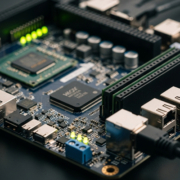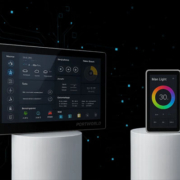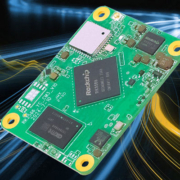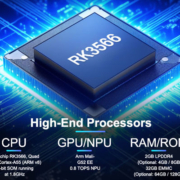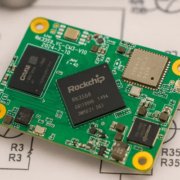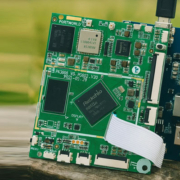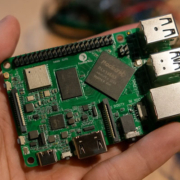What is the System on Module (SoM), and How to Choose
The Rise of Modular Embedded Computing
As embedded systems become more powerful and complex, developers are looking for ways to speed up development cycles while reducing risk and cost. One solution that’s gaining massive popularity in industrial applications, smart home devices, and custom hardware design is the System on Module (SoM). But what exactly is a SoM, and how do you choose the right one for your project?
This article breaks down the fundamentals of SoMs, their benefits, common use cases, and key factors to consider when selecting one—especially for smart devices like control panels and IoT gateways.
What is a System on Module (SoM)?
A System on Module (SoM) is a compact, ready-to-integrate computing module that contains the core components of a computer system, including:
- Processor (CPU/MCU)
- Memory (RAM, Flash)
- Power Management
- Connectivity (Ethernet, Wi-Fi, USB, etc.)
- Operating System Support (Linux, Android, RTOS)
Unlike a single-board computer (SBC) that includes all I/O interfaces, a SoM is designed to be plugged into a Carrier Board or Base Board, which handles application-specific I/O such as HDMI, GPIO, CAN bus, RS485, camera interfaces, and more.
SoMs offer a modular approach to embedded product development—allowing the core logic to remain unchanged while the baseboard is tailored to the specific needs of the application.
Benefits of Using a SoM
-
Faster Time to Market
SoMs reduce design complexity by offloading CPU and memory layout, allowing developers to focus on peripheral and I/O design. -
Scalability
Many SoMs are pin-compatible across product families, making it easy to upgrade performance without redesigning the entire system. -
Reduced Development Risk
Since the core computing logic is pre-tested and production-ready, SoMs lower the risk of hardware bugs and long debugging cycles. -
Compact Size
Highly integrated designs allow SoMs to fit into space-constrained applications like smart control panels, medical devices, and industrial sensors. -
Custom Carrier Board Design
You can design your own baseboard to meet unique needs—such as custom connectors, display interfaces, or industry-specific requirements.
Where Are SoMs Used?
- Smart Home Control Panels
- HMI Devices in Industrial Automation
- Medical Equipment
- Retail Kiosks and POS Terminals
- IoT Edge Gateways
- Surveillance and Security Systems
- Robotics and Drones
How to Choose the Right SoM
Choosing a suitable SoM depends on your project’s requirements. Here are the top factors to consider:
1. Processor Architecture
- ARM Cortex-A7, A53, A72 – for Linux/Android-based systems.
- ARM Cortex-M series – for low-power real-time applications.
- Consider processing needs: multimedia, AI, real-time control, etc.
2. Memory & Storage
- RAM: 512MB to 4GB, depending on OS and workload.
- Flash/eMMC: 4GB to 64GB for OS, logs, and data.
- Make sure it supports external SD cards or SSDs if needed.
3. Operating System Support
- Android (for rich UIs like smart panels)
- Linux (for flexible, open-source control)
- RTOS (for real-time, low-latency systems)
4. Connectivity Interfaces
- Ethernet, Wi-Fi, Bluetooth, 4G/LTE
- Serial (RS232/RS485), USB, GPIOs
- Display interfaces: LVDS, HDMI, MIPI-DSI
5. Thermal & Power Requirements
- Evaluate operating temperature range for harsh environments.
- Consider heat dissipation and power efficiency.
6. Longevity & Supply Chain
- Choose vendors that offer long-term supply support (5-10 years).
- Ensure documentation, SDKs, and BSPs are available.
7. Form Factor & Pinout Compatibility
- Standard SoM formats: Qseven, SMARC, µQseven, or custom.
- Check for mechanical compatibility with existing baseboards.
Portworld’s Embedded SoM Solutions
Portworld offers a range of reliable, cost-effective System on Module (SoM) solutions based on ARM architecture, ideal for applications such as smart home control panels, edge devices, and custom automation systems.
Why Choose Portworld’s SoM:
- Android/Linux dual OS support
- Quad-core ARM Cortex-A7/A53 processors
- Rich interfaces (USB, UART, CAN, RS485, GPIO)
- Custom carrier board design service
- PoE-enabled and low-power options
- CKD/SKD supply for flexible regional assembly
Whether you’re a hardware startup or an established integrator, Portworld helps you rapidly prototype and scale with reliable embedded modules and engineering support.

